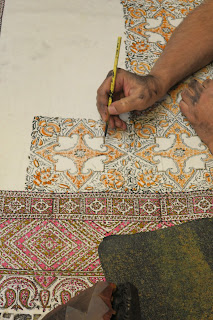Qalamkar is a form of Persian woodblock printed textile that originates from Esfahan in central Iran over 400 years ago. Unlike some lesser quality, machine-printed fabrics coming out of India, Pakistan and China recently, each design of Qalamkar is traditionally hand-printed by the few independent craftsmen still spread throughout Esfahan.
The materials used to produce Qalamkar are 100% natural! From the cotton fabric to the pigments and dyes used for printing, every single ingredient of Qalamkar is natural and derived from local sources. As Qalamkar have been produced since the 1600's, they pre-date many technical and chemical processes and reached their level of being a refined art before many artificial additives were even invented.
Traditionally patterns and motifs were derived from the Safavid architecture of the time. Currently, the most popular pattern in Iran is a lattice design originating on the roof of the famous Jameh Mosque in Esfahan.
The uses of Qalamkar are many and incredibly varied. Today they are mainly displayed for their intricate beauty around the home as tablecloths, wall hangings, table runners, light rugs and bed spreads. Traditionally they have also been known to be used as prayer mats and in clothing.
The materials used to produce Qalamkar are 100% natural! From the cotton fabric to the pigments and dyes used for printing, every single ingredient of Qalamkar is natural and derived from local sources. As Qalamkar have been produced since the 1600's, they pre-date many technical and chemical processes and reached their level of being a refined art before many artificial additives were even invented.
Traditionally patterns and motifs were derived from the Safavid architecture of the time. Currently, the most popular pattern in Iran is a lattice design originating on the roof of the famous Jameh Mosque in Esfahan.
The uses of Qalamkar are many and incredibly varied. Today they are mainly displayed for their intricate beauty around the home as tablecloths, wall hangings, table runners, light rugs and bed spreads. Traditionally they have also been known to be used as prayer mats and in clothing.
Factory of Handprint, Bazar, Isfahan




